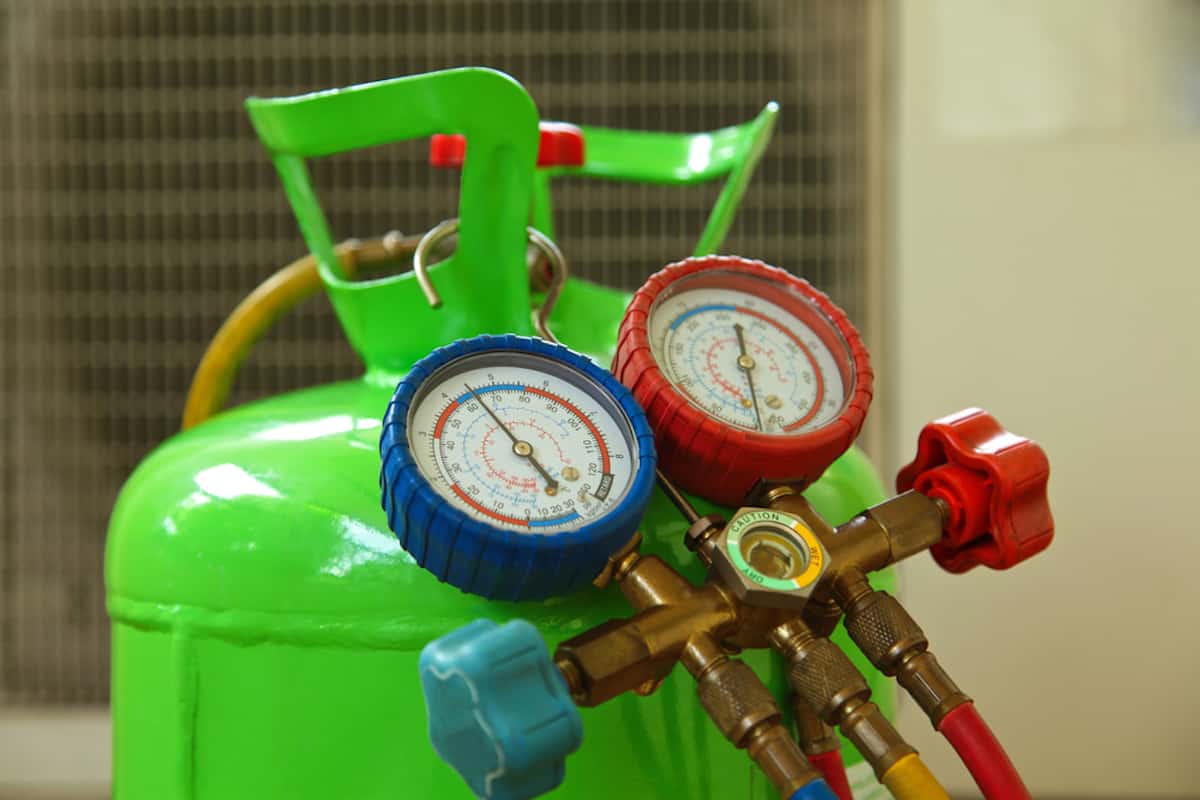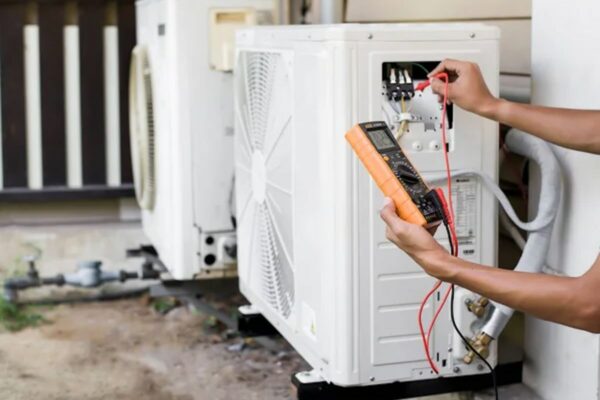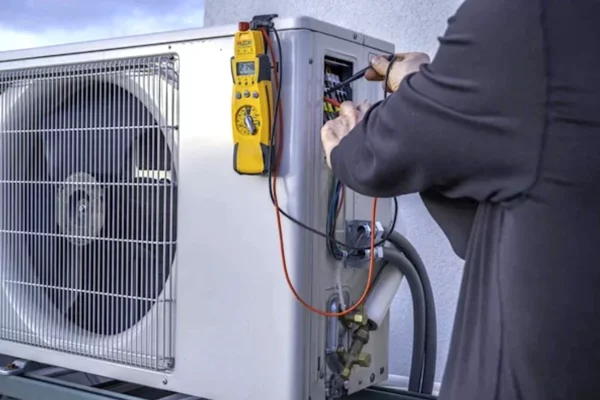5 Types of Refrigerants in Air Conditioning
Refrigerant is an essential element in air conditioning. Since the beginning of air conditioning, many types of refrigerants are invented and implemented. So, what are the common types of refrigerants used in air conditioning today?
Currently, the 5 common types of refrigerants in air conditioning are:
- R22 Refrigerant
- R410A Refrigerant
- R32 Refrigerant
- R134a Refrigerant
- R513A Refrigerant
Different types of air conditioners use different refrigerants. Some refrigerants are phasing out soon due to environmental concerns. So, let’s take a closer look at each refrigerant.
R22 Refrigerant
Worldwide speaking, R22 refrigerant is still the most used refrigerant in air conditioners today. However, it is being phased out and thus, R22 refrigerant is mostly found in old split and window air conditioners.
R22 refrigerant is considered a high operating pressure refrigerant. The suction pressure of R22 air conditioners is usually around 75 psi (517 kPa).
R22 refrigerant has a GWP (global warming potential) of 1810 and an ODP (ozone depletion potential) of 0.055.
R22 refrigerant is a non-flammable and non-toxic refrigerant that is perfect for residential applications.
The main benefit of R22 refrigerant is its high energy efficiency compared to other refrigerants.
However, due to its high GWP and ODP, the production of new R22 air conditioners was limited in 2010 and banned completely since 2020 in accordance with the Montreal Protocol [reference].
Although the production of R22 air conditioners is limited, there are still plenty of R22 air conditioners in operation around the world now.
Since R22 refrigerant is more harmful to the environment and the world is phasing it out, new residential air conditioners are now using R410A refrigerant which is a direct replacement for R22 refrigerant.
R410A Refrigerant
In terms of newly produced air conditioners, R410A refrigerant is the most common refrigerant used in residential air conditioners.
Currently, residential split air conditioners (mini splits), window air conditioners and portable air conditioners are using R410A refrigerant.
In commercial applications, R410A refrigerant can be found in air-cooled scroll chillers and air source heat pumps (hot water).
R410A refrigerant has a GWP of 2088 but its ODP is zero, meaning R410A refrigerant does not cause any harm to the ozone.
Hence, R410A refrigerant is considered safer than R22 refrigerant which is why it is a direct replacement for R22 refrigerant despite being slightly higher in GWP.
R410A refrigerant is also a high-pressure refrigerant.
The suction pressure of R410A air conditioners is usually around 125 psi (862 kPa) which is much higher than R22 air conditioners.
Hence, R22 air conditioners are not safe to use R410A refrigerant as the material used in R22 air conditioners may not able to withstand higher operating pressure.
Similarly, R410A refrigerant is also a non-flammable and non-toxic refrigerant that is suitable for residential applications.
However, R410A refrigerant is about 6% less efficient than R22 refrigerant when all design variables are held constant.
Nonetheless, the damage done by R22 refrigerant to the environment is prioritized over the slight decrease in the efficiency of R410A air conditioners.
R410A refrigerant is a unique refrigerant compared to other refrigerants because it is a blend of two different refrigerants (50% R32 + 50% R123). Hence, it must be charged into an air conditioner in liquid form while non-blended refrigerants like the R22 refrigerant are charged in gas form.
That’s why many R410A refrigerant gas tanks are upside down when charging into an air conditioner. Technicians are pumping in liquid refrigerant instead of gas refrigerant.
Despite being a more environmental-friendly refrigerant, R410A refrigerant is still not good enough. Hence, R410A air conditioners are scheduled to be phased out starting on 2023 and the replacement is air conditioners with R32 refrigerant.
In the meantime, I would like to inform you that you can learn quicker by getting my HVAC Begin (eBook) if you’re a beginner. But, if you have a year or two of experience, then I would suggest you consider my HVAC Basics (eBook). Nonetheless, I encourage you enroll in my HVAC Beginner Course: 10 Days to Become Competent in HVAC if you want to equipped yourself with a complete set of basic HVAC skills.
HVAC Beginner Course
Learn the most basics and foundational HVAC skills including cooling capacity calculation, equipment selection, duct sizing, pipe sizing, exhaust fan sizing, controls, electrical and more.
R32 Refrigerant
R32 refrigerant is the latest refrigerant used in residential air conditioners including split air conditioners (mini splits) and window air conditioners.
The efficiency of R32 refrigerant is comparable to R22 refrigerant. On top of that, R32 refrigerant is about 3% more efficient than R410A refrigerant when all design variables are held constant.
Furthermore, R32 refrigerant does not harm the ozone and it has a GWP of 675, much lower than both R22 refrigerant and R410A refrigerant.
Hence, R32 air conditioners are more efficient and cause less harm to the environment.
However, the drawback of R32 refrigerant is its flammability. Under extreme conditions, R32 refrigerant may be caught on fire. But, it is extremely unlikely to happen.
Nonetheless, R32 refrigerant is classified as slightly flammable rather than non-flammable.
Fortunately, R32 refrigerant is a non-toxic refrigerant that is much needed for residential applications.
The operating pressure of R32 air conditioners is similar to R410A air conditioners at around 125 psi (862 kPa) of suction pressure.
Hence, R410A air conditioners can use R32 refrigerant though it is not recommended because R410A refrigerant is a mixture while R32 refrigerant is not.
Although R32 refrigerant is more efficient, it is not the only reason why modern air conditioners are more efficient. Technological advancement has also played a role in improving the efficiency of air conditioners over the year.
As of now, R32 refrigerant is the latest refrigerant that is still implementing in many residential air conditioners. The transformation from R410A refrigerant to R32 refrigerant is still ongoing. Soon, all residential air conditioners will be using R32 refrigerant.
Until a better refrigerant is developed, new air conditioners will find themselves using R32 refrigerant.
R134a Refrigerant
R134a refrigerant is widely used in commercial air conditioning units such as air-cooled screw chillers, water-cooled chillers and water source heat pumps (hot water).
Apart from air conditioning in buildings, R134a refrigerant is widely used in vehicle air conditioners.
R134a refrigerant has a GWP of 1430 and ODP of zero. It is less harmful to the environment compared to R22 refrigerant and R410A refrigerant but not as good as R32 refrigerant.
R134a is considered a low operating pressure refrigerant. Chillers and heat pumps that use R134a refrigerant often have a suction pressure of around 37 psi (255 kPa).
However, such a low operating pressure is prone to freezing if there is a slight mistake like undercharging or minor leaks.
On the bright side, since R134a refrigerant allows a much lower operating pressure, the overall cost of R134a air conditioning units is much lower because the material strength doesn’t have to be as high.
Furthermore, lower operating pressure translates into higher efficiency due to less waste heat being produced in the process. In addition, lower operating pressure also translates into lower leak potential.
The efficiency of R134a is similar to R22 refrigerant and R32 refrigerant. However, it is slightly toxic but non-flammable. Hence, it is mostly used in commercial applications.
New refrigerants such as R513A refrigerant and R514A refrigerant are gradually replacing R134a refrigerant. As of now, certain types of new vehicles are no longer allowed to use R134a air conditioners.
Soon, other R134a air conditioning units will be replaced with R513A refrigerant or other equivalents.
R513A Refrigerant
R513A refrigerant is a new refrigerant in commercial applications. Currently, only large water-cooled centrifugal chillers, especially with magnetic bearing have the option to use either R513A refrigerant apart from the conventional R134a refrigerant.
R513A refrigerant has a GWP of 573 and an ODP of zero which is much better than R134a refrigerant and even R32 refrigerant. However, it is slightly toxic but non-flammable.
R513A is a direct replacement for R134a refrigerant. Hence, it is also a low operating pressure refrigerant. The suction pressure of R513A centrifugal chillers is usually around 40 psi (276 kPa).
However, the efficiency of R513A refrigerant is slightly lower than R134a refrigerant. When all design variables are held constant, R513A refrigerant is about 3% less efficient than R134a refrigerant.
Nonetheless, as the world is moving towards a more environmental-friendly future due to climate change, R513A refrigerant is preferred despite being slightly less efficient.
Final Thought
Residential air conditioners are transitioning to R32 refrigerant. For commercial chillers, R513A refrigerant is being adopted by many large manufacturers. However, other equivalent refrigerants (or better ones) such as R514A and R1233zd are also being adopted by a few brands.
Nonetheless, more and more environmental-friendly and efficient refrigerants are being developed to reduce the impact of air conditioning as we move towards a brighter future.
Lastly, consider my HVAC Begin (eBook) if you’re a beginner and you want to have a foundational knowledge in HVAC. But, if you have a year or two of experience, then I would suggest you consider my HVAC Basics (eBook). Nonetheless, I encourage you enroll in my HVAC Beginner Course: 10 Days to Become Competent in HVAC if you want to equipped yourself with a complete set of basic HVAC skills.
HVAC Beginner Course
Learn the most basics and foundational HVAC skills including cooling capacity calculation, equipment selection, duct sizing, pipe sizing, exhaust fan sizing, controls, electrical and more.
If you have anything to add (or ask) about this topic, leave a comment down below!









